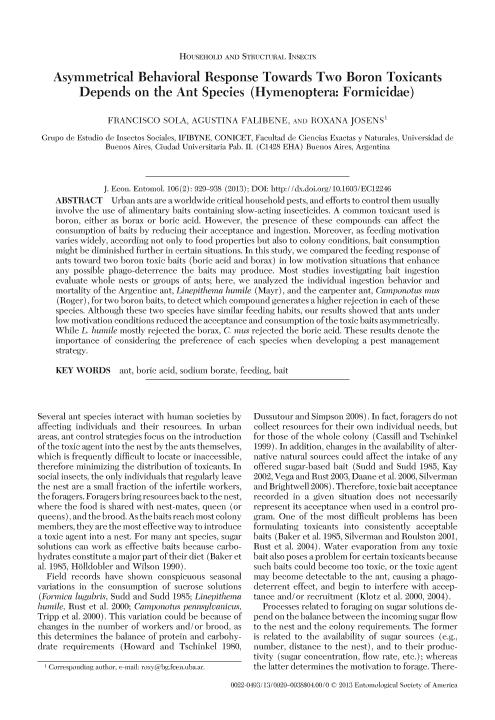Artículo
Asymmetrical behavioral response towards two boron toxicants depends on the ant species (Hymenoptera: Formicidae)
Fecha de publicación:
09/2014
Editorial:
Entomological Society of America
Revista:
Journal Of Economic Entomology
ISSN:
0022-0493
e-ISSN:
1938-291X
Idioma:
Inglés
Tipo de recurso:
Artículo publicado
Clasificación temática:
Resumen
Urban ants are a worldwide critical household pests, and efforts to control them usually involve the use of alimentary baits containing slow-acting insecticides. A common toxicant used is boron, either as borax or boric acid. However, the presence of these compounds can affect the consumption of baits by reducing their acceptance and ingestion. Moreover, as feeding motivation varies widely, according not only to food properties but also to colony conditions, bait consumption might be diminished further in certain situations. In this study, we compared the feeding response of ants toward two boron toxic baits (boric acid and borax) in low motivation situations that enhance any possible phago-deterrence the baits may produce. Most studies investigating bait ingestion evaluate whole nests or groups of ants; here, we analyzed the individual ingestion behavior and mortality of the Argentine ant, Linepithema humile (Mayr), and the carpenter ant, Camponotus mus (Roger), for two boron baits, to detect which compound generates a higher rejection in each of these species. Although these two species have similar feeding habits, our results showed that ants under low motivation conditions reduced the acceptance and consumption of the toxic baits asymmetrically. While L. humile mostly rejected the borax, C. mus rejected the boric acid. These results denote the importance of considering the preference of each species when developing a pest management strategy.
Palabras clave:
Ant
,
Boric Acid
,
Sodium Borate
,
Feeding
,
Bait
Archivos asociados
Licencia
Identificadores
Colecciones
Articulos(IFIBYNE)
Articulos de INST.DE FISIOL., BIOL.MOLECULAR Y NEUROCIENCIAS
Articulos de INST.DE FISIOL., BIOL.MOLECULAR Y NEUROCIENCIAS
Citación
Sola, Francisco Javier; Falibene, Agustina; Josens, Roxana Beatriz; Asymmetrical behavioral response towards two boron toxicants depends on the ant species (Hymenoptera: Formicidae); Entomological Society of America; Journal Of Economic Entomology; 106; 9-2014; 929-938
Compartir
Altmétricas




